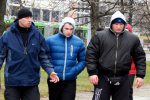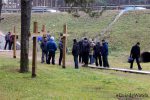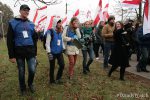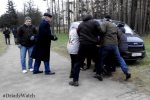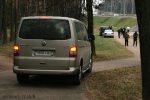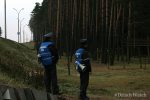Report on the monitoring of “Dziady-2014”
The traditional commemorative action in the memory of ancestors, "Dzyady-2014", including a march and a rally, took place on November 2, 2014. The event was organized by the Conservative Christian Party BPF.
Its format, authorized by the Minsk City Executive Committee, included gathering of demonstrators outside the building of the Minsk watch factory and a procession to Kurapaty forest on the following route: Nezalezhnastsi Avenue, Kalinouski, Sivykh, Karbyshau, Hamarnik and Mirashnichenka streets, Minsk ring road and the rally in Kurapaty. The time frame – 10.30 a.m. - 5.00 p.m.
Observers from the Human Rights Centre "Viasna" and the national human rights public association "Belarusian Helsinki Committee" monitored the whole action. The Monitoring group consisted of 13 members designated by badges and blue jackets. The observers filled unified blanks of monitoring.The objectives of monitoring were to:
- register important elements of the march and rally, which together allow to characterize the mass event as peaceful or non-peaceful;
- register the interference with the right to freedom of peaceful assembly by third parties;
- assess the actions of the authorized bodies to ensure security during mass events;
- make recommendations to the government representatives, as well as the organizers of the event.
General conclusions
The collected data allow us to assess the mass event as peaceful [1] during the entire assembly.
We positively assess actions of the traffic police to ensure the movement of the column through the corners along the route of the procession. We also welcome the presence of specially designated police information service officers.
However, challenges remain in the work of the police aimed at maintaining public order during mass events. There was an interference with the freedom of peaceful assembly, namely groundless detention of participants which should be assessed as illegal and arbitrary.
We are still worried with the impossibility to identify law enforcement officers as such due to the lack of uniform, as well as the absence of identification cards on the clothes of policemen in the form. Here we note the impossibility of identification of the vehicles, which were used by law enforcement agencies, as well as the lack of ambulance car at the mass action.
In such circumstances there is doubt in the possibility of the police to adequately fulfill their function of protecting public order, since the participants in case of need will not know who to turn to for help. Furthermore, the inability to identify the police officers endangers abuses on their part.
It should also be noted that the regulation of the order of holding mass assemblies in Belarus, adopted by the Law "On mass events in the Republic of Belarus" dated December 30, 1997 (as amended on 08.11.2011), is contrary to international standards. In a joint opinion of the Venice Commission and OSCE / ODIHR (CDL-AD (2012) 006) it is observed: "The law on mass events is characterized by excessive regulation of the procedural aspects of the assembly. The law creates a complex procedure under strict and time-consuming procedures for obtaining permits, at the same time leaving more leeway to the administrative authorities in the application of the Act. This procedure does not reflect the positive obligation of the state to ensure and promote the right to freedom of peaceful assembly and freedom of expression." In addition, the United Nations Human Rights Committee has repeatedly pointed out violations of the right to freedom of peaceful assembly by Belarus (Article 21 of the International Covenant on Civil and Political Rights).
Pace of the procession
The timing, format and route of the event corresponded to the application. The estimated number of participants in the different periods of the event ranged from 240 to 400 people.
Conditions for the work of observers
There were obstacles to the work of observers: a policeman tried to expel an observer from the pedestrian underground crossing near the metro station “Park Chaliuskintsau” without giving any explanations. The policemen prohibited to take photos during the attempt of detention of a demonstrator. Communication with law enforcement officials was controversial. On the one hand, they were open to contacts with observers and showed their IDs. On the other hand, they refused to provide statistic and other information.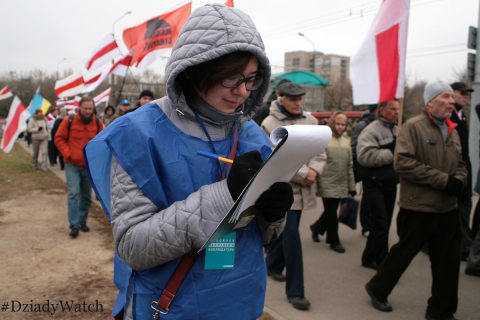
Work of the media
No obstacles were registered.
Actions of the organizers
Organizers were designated with badges. There were representatives of vigilantes, marked with white-red-white armbands or orange vests. According to the organizers, there were about 20 vigilantes, who monitored the procession, organizing the transition of the column through the roadway, and interacted with the road police.
Actions of the participants
There weren't registered any violent action on the part of the participants. Demonstrators followed the requirements of the organizers and law enforcement officials. They used the following slogans: "Long live Belarus!", "Putin is d*ckhead!," "Glory to Ukraine – glory to heroes!", "Putin is bad!" "Faith, party, state!" "Glory to the fighters!" "Glory to the nation - death to the enemies!" "Together forever!"," We believe, we can, we will win!" and sang songs.
They used placards and banners with the following texts: "Dziady", "Let us commemorate our ancestors", "Defend Belarus from Russian imperialism", "Dziady – remember the victims of the Bolsheviks", "Conservative Christian Party - BPF", "Let's commemorate Kurapaty victims", "Lithuania's mother, pray for us" (in Latin). They also carried white-red-white flags, flags of Ukraine, symbols of Belarusian Christian Democracy, BPF Young Front and Young Belarus.
At the meeting there was read out a letter from Zianon Pazniak on how to commemorate the victims of Kurapaty; people spoke about the history of the discovery of Kurapaty, called to respect the Belarusian language; spoke about the danger of Russian imperialism and aggression against Ukraine; about the Russification of culture and the thesis that the "youth who speak in Russian support the occupation"; the responsibility of every one to defend the country and uselessness of the Russian military bases.
Organization of the work of law enforcement agencies
The estimated number of law enforcement officers: the number of policemen in the uniform was about ten, the number of people in the uniform of riot police was about four, the number of road policemen in the uniform – about ten. There were also about 40 policemen in plain clothes (wearing headphones or carrying walkie-talkies who accompanied the procession. It was impossible to identify them due to the lack of badges.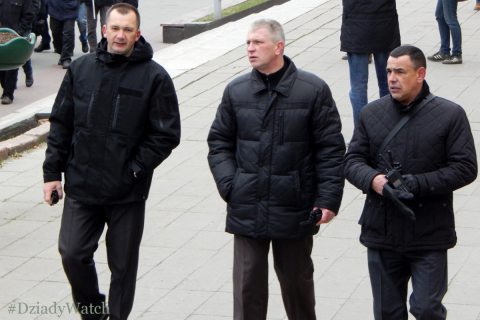
We should note the efforts of traffic police to ensure the smooth movement of the procession. On one of the parts of the procession they removed a metal fence so that people could proceed along the carriage way. At certain intersections they temporary blocked the movement of vehicles so that the column could proceed. However, in some other cases, the road was not blocked and the column was divided.
During the entire event the procession was accompanied with cars belonging to law enforcement agencies. However, they didn't have any special number plates or coloring, and could be identified only by the policemen getting in and out. They parked at the parking lot near the entrance to Kurapaty. 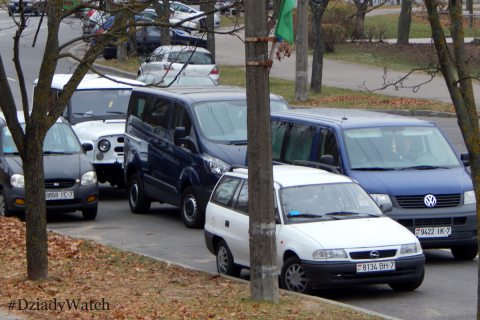
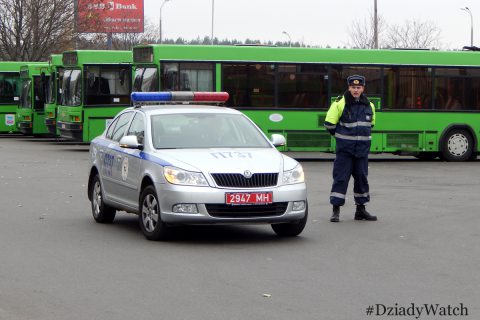
Detentions
Several detentions were reported.
1) The first one occurred at the metro station "Ukshod", when two participants of the mass event left the procession and were detained by police to be "checked for possession of unregistered symbols" and were released after a talk.
2) During the procession near Mirashnichenka street, 14, a youngster started shouting "Where are the official, red-green flags?". The organizers of the action appealed to the police and asked to lead him away. The youngster proceeded with the policemen to a car without any special marks, by which it could be identified as a police vehicle.
3) After the meeting at the exit of Kurapaty people in plain clothes tried to detain a woman and a youngster who carried Ukrainian flags. The observers registered verbal aggression towards the demonstrators on the part of the people in plain clothes, as well as the use of violence, including an attempt to pull the woman in a minibus without any marks indicating that it was a police car. Two police officers in uniform watched the incident, without trying to interfere.
4) After the end of the rally, demonstrator Aliaksei Dvaretski was detained near Kamarouski market. He was guarded to the Savetski District Police Department, where police threatened to him and tried to provoke aggression. They released the detainee in two hours, after seizing leaflets, flags and ribbons without drawing any reports of confiscation.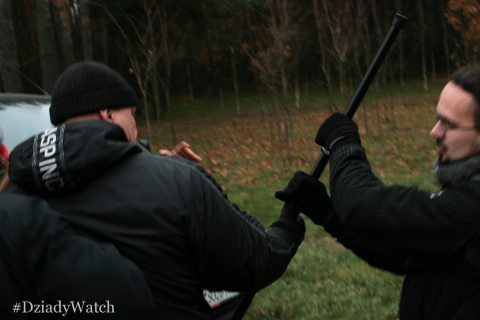
Organization of medical assistance
There was no ambulance car following the route of the action.
Recommendations
Law enforcement officials should:
- stop the systematic practice of arbitrary detention of participants of peaceful assemblies;
- stop the movement of vehicles for the time, necessary for the transit of the whole procession through a road;
- Comply strictly with the requirements of Article 5 of the Law of the Republic of Belarus "On the Internal Affairs", according to which "the activities of the bodies of interior are open", and maintain public order during mass events wearing the uniform and identification cards (badges). Police cars must also be marked accordingly.
- ensure that a procession is accompanied by an ambulance car.
Subjects who have the right of legislative initiative should:
- Initiate changes in the legislation to bring it into compliance with international standards in the field of peaceful assembly.
[1] According to the guidelines of the OSCE on freedom of assembly, an assembly should be defined as peaceful, if its organizers have peaceful intentions (http://www.osce.org/ru/odihr/24524?download=true)





